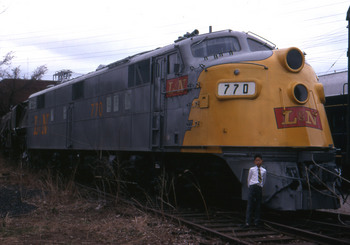Speed Lettering 08 – streamlined form [Column_Letters & Figures]
 : Louisville, KY. Spring, 1971
: Louisville, KY. Spring, 1971Some streamlined forms came from aerodynamics. Some streamlined forms came from elegance. The origin and thus the definition of the streamlined forms are complicated.
The general understanding for the streamlined railway equipment is that it works a little but does not pay (besides today’s high-speed trains). Thus it’s ineffectual and deceptive.
We know that commercial airlines were established in the ‘20s. But the streamlined express trains did run faster than local trains and freight trains. Why the image of deceptive appearance was born? I think that the image was generated by itself.
This is how I think. Psychology explains that the wedge-shaped objects bring the image of speed. But this image was brought to the passengers by the form of a streamlined train tied down at the station track before it showed its performance. The effect brought by the form was so effective that the real performance couldn’t catch up with it. Thus the image of deceptive appearance was born.
Here I represent my definition of the streamlined form; the form wedged and ineffectual.
If so, the streamlined form should have wedges. The streamlined equipment should have edges somewhere on the nose.
Looking from the side, all the EMD’s E series locomotives have slant form. But only E3A to E6A have edges on their nose. Thus I tentatively say that E3A to E6A is the real streamlined equipment.
See the edge on the nose of L&N 770, an EMD E6A found at its namesake city, Louisville?
流線型については、小島英俊氏が大著「流線形列車の時代」(2005、NTT出版)にまとめられている。
氏の解説によれば、130km/h程度での走行において、空気抵抗はそれほど重要ではない。つまり、130km/h程度で走行する車両を流線型にすることで若干の物理的効果は得られるが、工賃アップや客席数減など経済的には逆効果である。総体としてはさほど効果的だとはいえない。昨今の高速鉄道車両を除けば、早く走れなくはないが割に合わないという理解が流線型に対する一般的な理解であろう。
確かに、1920年代にはいくつかの民間航空会社が設立され、以降、速達度における鉄道の優位は失われつつあった。とはいえ、流線型車両の多くは優等列車に充当されたので、たとえその形状はスピード向上にさほど資するものではなかったにせよ、他の列車よりは速かったはずである。にもかかわらず、それが見かけ倒しであるかのようにいわれるのは、これまで記してきたみかけの運動による効果が逆に働いていると考えることができる。つまり、「クサビ形(<、>字)の形体」であるが故に、みかけの運動による効果が実感より先行して駆動した結果、実感は遅延してしまったのではないか、と推察できる。
どのような形体を流線型というか、その定義ははっきりしたものではない。造形的根拠によるものや空力学的根拠によるものが混交している。先に記した一般的な理解および推察を重ね、事後的に定義してみると、流線型とはさほど効果的だとはいえない「クサビ形(<、>字)の形体」をしたものだといえる。
であれば、流線型だというには、「クサビ形(<、>字)の形体」、つまり尖端がとがっている必要がある。「⊂、⊃字」ではない。エッジが立っているものこそ流線型と呼ぶにふさわしい、ということになる。EMDのEシリーズ機関車は、いずれも横から見れば、確かにどれも尖っている。しかし、鼻筋の通っているE3〜E6こそ流線型だといえるのではないか。
2011-07-07 23:22
コメント(0)
トラックバック(0)




コメント 0